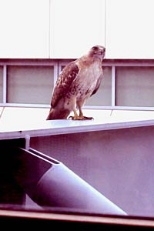Marilyn Wilson, a career development counselor at MIT, launched a campus-wide e-mail dialogue when she asked members of the MIT Editors' Club about two hawks she spotted circling Building 10 last week.
Below is the thread of swift and lively responses Wilson received during the course of the workday from various Institute naturalists about the North American red-tailed hawks (Buteo jamaicensis) who have made MIT their home.
Marilyn Wilson: As I was driving in to work today at about 8:30, there were two hawks circling above MIT, roughly around Building 10. Usually hawks move upward but these two seemed to be staying level, circling and circling. Does anyone know anything about this visitation from the Natural World? Do we have hawks in residence nearby? Symbolic predation?
Rick Borchelt: There is a pair of nesting red-tails that frequent the Kendall Square vicinity. They've learned to snatch pigeons--red-tails usually feed on mice, voles and rabbits and in the normal wild don't take prey on the wing. There's also a pair of American kestrels I see occasionally over near Volpe (Transportation Center).
Patti Foley: There are a number of hawks in residence. I, too, saw a hawk as I was walking through campus this morning. It had just flown from the area of the biology building and then landed on the overhead structure at the edge of the List Center building where it perched. It was for me a great way to start the morning.
Jennifer Pell Gordon: Yeah, some large birds--dunno if they're hawks--hang out here; I used to watch one of them all the time from my lab in Bldg. 4 (overlooking the trees in Killian Court). One of the others in our office mentioned that she saw one grab a squirrel once. (Yum!)
Kathryn Rotondo: On the same meme, the Globe recently reported a turkey in Kendall Square: http://www.boston.com/dailyglobe2/178/metro/Not_so_wild_after_all+.shtml
Lee Ridgway: From my window in N42, I often see a hawk scouting out lunch or perched on the old Polaroid building at Main & Windsor streets.
Jeremy Grainger: Did y'all see The Tech's photo of a red-tailed hawk on the Green Building? http://www-tech.mit.edu/V123/N28/hawkDONE.28p.html
Mary Cabral: Actually the red-tailed hawks have been in residence at MIT for years--they seem especially to like Killian courtyard. I once had a window-side office in building 4 and watched them take over and rebuild a squirrel nest on that side of the green; they also have a favorite tree that some call the "breakfast tree"--yup, they would dine there each morning. Some folks at MIT apparently have binoculars for hawk-watching. This spring I saw one hawk bringing nesting material to a tree nearby the Hermann building--so I guess they move around.
Terry Hill: Here in E40 and buildings nearby we have been enthralled all spring by the activities of a pair of red-tailed hawks who raised two chicks in a pine tree at the corner of Amherst and Wadsworth. The chicks have now fledged. After the Hatch, the Fledging was the most exciting week. The first to fly got itself trapped in an alley behind Building 31 and was fed throughout one weekend by MIT staff. It was restored to the tree by an intrepid young woman from Animal Rescue League on instructions from New England Wildlife Center, where Animal Rescue League staff deliver all the wild creatures taken into custody.
My fourth floor office window is right above the skywalk between E40 and E51. The hawks regularly perched there to scan the area for food (squirrels, pigeons, grackles, freshmen) and to snack on their kills before delivering them to their offspring. As the babies were growing, they demanded enormous amounts of food. Staff, students, and faculty members hung out of windows with binoculars and cameras. MIT animal lovers trooped in and out, and we on the E40 fourth floor instant messaged frantically whenever someone spotted a particularly interesting activity.
So the answers are that we know more than you want to know about this particular visitation; we hope the hawks will nest in our tree again next year, and their predation was quite literal. Maybe the ones near Building 10 were two of "ours." We miss them, and we've just about caught up on our work.
Scott Campbell: Didn't one of them hatch a chick in Killian Court a year or two back? I think so. Raised it right there, in a tree. Also saw one of them make off with a squirrel, carrying it out over the Charles. Does anyone know-when they do that, is the squirrel still alive?
Hill: Usually they are killed on impact, but not always. Nature's still red in tooth and claw, even here at MIT.
NATURE NOTE:
The red-tailed hawk, the most common raptor in North America, often catches its prey while flying, killing it with its sharp talons. It eats small rodents, opossums, reptiles and other birds, consuming the entire prey then regurgitating inedible parts. About 24 inches long, it weighs just over 2 lbs. and has a wingspan of over 4 feet. It mates for life and, when not bringing food to its nest, soars over its territory looking for intruders and lunch.






